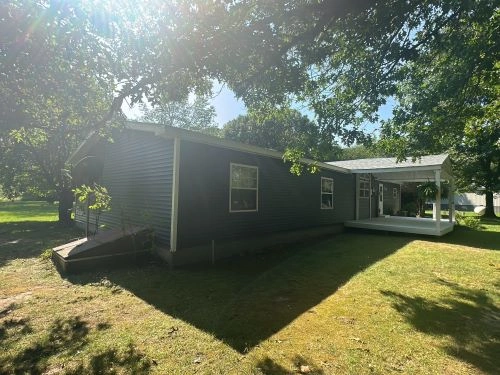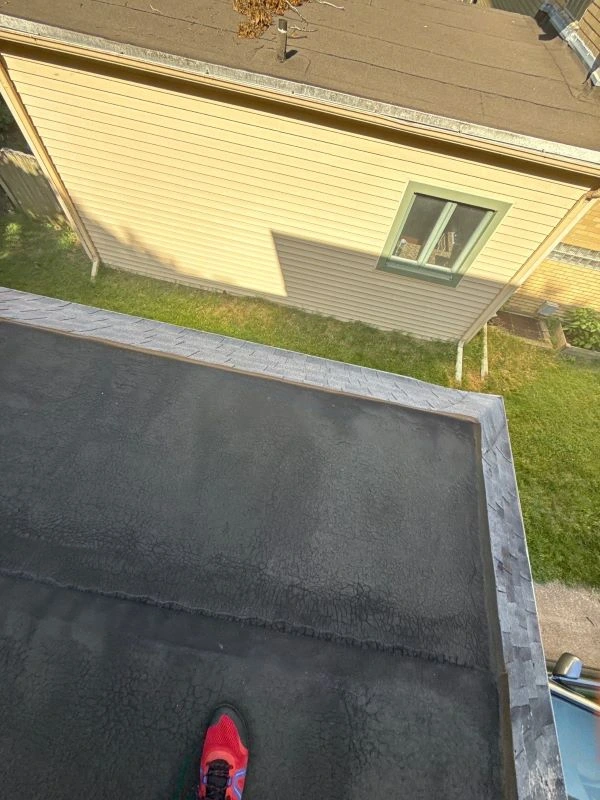How Seasonal Weather Affects Your Roof’s Health
Your roof is your home’s first line of defense against the elements, and its durability is constantly tested by changing weather conditions throughout the year. From scorching summer sun to freezing winter storms, every season presents unique challenges that can impact your roof’s performance, longevity, and overall health. For homeowners searching for residential roof repairs near me or looking for professional roof leak repair, understanding how seasonal weather affects your roof can help you take proactive steps to protect your investment.

Spring: Heavy Rain and Moisture Challenges
Spring showers may bring flowers, but they can also expose hidden vulnerabilities in your roofing system.
- Increased Leak Risks: Persistent rainfall can penetrate weak points, such as compromised flashing or missing shingles, leading to interior water damage.
- Gutter Overflows: Clogged gutters from leftover winter debris can cause water backup, which may seep under shingles and damage the fascia.
- Moss and Algae Growth: Damp conditions create the perfect environment for moss and algae, which hold moisture against shingles and shorten their lifespan.
Maintenance Tip: Clear gutters, inspect for leaks, and remove moss early in the season. A simple inspection can help prevent costly roof leak repair later.
Summer: Heat and UV Radiation
Summer heat is one of the most damaging seasonal elements for roofs.
- Shingle Deterioration: Prolonged UV exposure dries out asphalt shingles, causing them to crack, curl, or lose granules.
- Thermal Expansion: Rising temperatures cause roofing materials to expand and contract, loosening fasteners and creating gaps.
- Ventilation Stress: Poor attic ventilation traps heat, raising indoor temperatures and increasing cooling costs while straining the roof structure.
Maintenance Tip: Schedule a professional roof inspection before peak summer. Adequate attic ventilation and reflective roofing options can reduce heat-related damage.
Fall: Debris and Preparation Season
Autumn’s falling leaves and cooler temperatures signal the need for preventative roof care.
- Gutter Blockages: Leaves, twigs, and debris accumulate in gutters, leading to water overflow and potential roof leaks.
- Branch Damage: Overhanging branches can scrape shingles or fall during strong winds, puncturing the roof.
- Hidden Weaknesses: Small cracks or loose shingles unnoticed in fall can worsen once winter snow arrives.
Maintenance Tip: Clean gutters thoroughly, trim nearby branches, and address minor issues before they escalate into residential roof repairs.
Winter: Snow, Ice, and Freeze-Thaw Cycles
Michigan winters bring harsh conditions that put roofs to the ultimate test.
- Snow Load: Excessive snow accumulation places significant stress on the roof, which can result in sagging or, in severe cases, structural collapse.
- Ice Dams: When melting snow refreezes along the roof’s edge, it creates ice dams that trap water beneath shingles and lead to interior leaks.
- Freeze-Thaw Damage: Continuous cycles of freezing and thawing widen existing cracks in shingles and flashing, weakening the roof over time.
Maintenance Tip: Maintain adequate insulation and ventilation in your attic to minimize ice dam formation. Use a roof rake to safely clear excess snow and reduce unnecessary weight on your roof.
Signs Seasonal Weather Has Damaged Your Roof
Identifying warning signs early helps you avoid bigger, costlier issues.
- Water Stains on Ceilings or Walls – Often a sign of hidden roof leaks after heavy rain or melting snow.
- Granules in Gutters – A clear indicator that shingles are deteriorating due to sun exposure or storm wear.
- Sagging Roof Deck – Caused by trapped moisture or snow weight weakening the roof’s structure.
- Curling or Cracked Shingles – Common in both hot summers and freezing winters, these need quick replacement.
- Mold or Mildew Growth – Moisture trapped in attic spaces signals roof ventilation or leak issues.
DIY Tips for Seasonal Roof Care
While professional inspections are vital, homeowners can take steps to maintain their roof year-round:
- Seasonal Inspections: Walk around your home at the change of each season and look for missing or damaged shingles.
- Check Gutters and Downspouts: Ensure they are free of debris to prevent water backup and ice dams.
- Look for Flashing Issues: Examine flashing around chimneys, skylights, and vents for cracks or bending.
- Trim Overhanging Branches: Prevent damage from falling limbs and reduce debris buildup.
- Monitor Attic Conditions: Check for damp insulation, musty odors, or visible light entering through the roof deck.
How to Maintain Your Roof Through the Seasons
- Schedule Professional Inspections Twice a Year: A spring and fall inspection catch seasonal wear before it escalates.
- Keep Gutters and Roof Surfaces Clear: A clean system ensures proper drainage during heavy rain or melting snow.
- Invest in Preventative Repairs: Addressing minor leaks promptly saves money compared to emergency roof leak repair.
- Upgrade Aging Roofs: If your roof is over 20 years old, replacement may be more cost-effective than repeated seasonal repairs.
- Ensure Proper Ventilation and Insulation: These reduce moisture, control attic temperatures, and prolong roof life.
Why Choose Professional Residential Roof Repairs
When seasonal weather damages your roof, DIY fixes aren’t enough. Choosing a trusted contractor ensures lasting results:
- Accurate Diagnosis: Professionals spot hidden issues homeowners often overlook.
- High-Quality Materials: Expert roofers use materials designed to withstand Michigan’s climate.
- Efficient Repairs: Emergency leaks and structural issues are repaired promptly and correctly.
- Warranty Protection: Professional services preserve manufacturer warranties on shingles and other roofing materials.
- Peace of Mind: Hiring experts eliminates the risks of unsafe DIY work on steep, slippery surfaces.
FAQs About Seasonal Roof Care
1. How often should I have my roof inspected?
Most experts recommend professional inspections at least twice a year—once in spring and once in fall. Seasonal inspections help detect damage early, reducing the risk of expensive repairs or premature roof replacement. Most residential roof installations take 1–3 days, depending on roof size, complexity, and weather. Larger or specialty material roofs may require additional time for proper installation.
2. Can small roof leaks wait until spring or summer for repair?
No. Even small leaks can cause major damage if ignored, leading to mold, rot, and structural issues. Prompt roof leak repair prevents these problems and saves money in the long run.
3. What is the best way to prevent ice dams in winter?
Proper attic insulation and ventilation are key. These help maintain consistent roof temperatures, preventing melting snow from refreezing at the eaves and forming ice dams that lead to leaks.
4. How do I know if my roof needs replacement rather than repair?
If your roof is older than 20 years, has widespread shingle damage, or shows signs of sagging and leaks in multiple areas, a replacement may be more cost-effective than frequent residential roof repairs.
5. Are seasonal roof problems covered by insurance?
Storm-related damage, such as hail or wind, is often covered by homeowners insurance. However, gradual wear and neglect are typically not covered. Keeping up with maintenance ensures claims are more likely to be approved.
Protect Your Roof Year-Round with Worthy Construction LLC
At Worthy Construction LLC, we specialize in protecting Kalamazoo homes from the impact of seasonal weather. From preventative inspections to emergency roof leak repair, our team delivers reliable, professional, and high-quality service tailored to your needs.
📞 Call us today at (269) 207-7704
📧 Email: admin@worthyroof.com
🌐 Visit: worthyroof.com
Looking for reliable residential roof repairs near me? Worthy Construction LLC delivers expert solutions that protect your home year-round.






Trustindex verifies that the original source of the review is Google. Worthy Construction just replaced my roof, skylights, and gutters. I live out of town and selling my parent's house so this company came through a personal referral. Khari and team were such a joy to work with. He answered my questions, kept me updated on progress, did everything he said he was going to do, and met all of commitments on time. It's not easy to know what's happening while living out of town and I appreciate Khari's communication skills, timeliness, and overall this has been an amazing experience! I highly recommend Worth Construction!!Trustindex verifies that the original source of the review is Google. Worthy Construction did an excellent job replacing our roof. They were very easy to work with throughout the entire process. They answered all of our questions promptly and delivered a great finished product. I’d highly recommend them for your roofing needs.Trustindex verifies that the original source of the review is Google. Very professional, great guy that will work with you. Highly recommended for sure. Mr. Worthy is very dependable! He completed our roof on time and as expected!Trustindex verifies that the original source of the review is Google. Greatest service ever! Super fast and did a fantastic job. I will definitely save them to do future jobs that need to be fixed. The greatest ever!Trustindex verifies that the original source of the review is Google. My roof was very damaged, I had a huge hole in my roof from constant tree debris and age. I didn’t have any expectations going in to the project but I was greatly impressed with the speed of service! The ten we done in 2 days! They cleaned up afterwards, the materials were great quality and . The team replaced my entire rooftop. Mr. Worthy was very respectful and responsive to my concerns regarding the project, I would certainly recommend his company to anyone looking for a new rooftop!Trustindex verifies that the original source of the review is Google. He was a pleasure to work with. They were prompt and professional the whole project. He kept me informed the whole process and his work was of the highest quality. They were very respectful of my and my neighbor's properties. I am very very happy with the work they did for me.Trustindex verifies that the original source of the review is Google. Quality work! Highly recommended!Trustindex verifies that the original source of the review is Google. I didn't have much word done, but I called after noticing a leak in my ceiling after a storm. Khari answered right away and was able to come and take a look within a couple days. He found the problem and was able to fix if with just caulking for no charge, 100% recommendTrustindex verifies that the original source of the review is Google. We had our roof and some gutters done by Worthy Construction and not only was it very timely, but they also were very friendly. We had the unfortunate experience of having to replace roof sooner than expected and they came and explained everything to us and then gave us options that really worked for us. Khari and his team did a wonderful job for us and I would recommend their service again and again. When they were working on our roof they noticed a leak in one of our gutters and replaced that as well which was very helpful!Trustindex verifies that the original source of the review is Google. I needed a roof replacement, Mr. Worthy worked with me and my insurance company from start to completion. He gave me a time frame and he stuck with it. High praise for him and his professional team.




